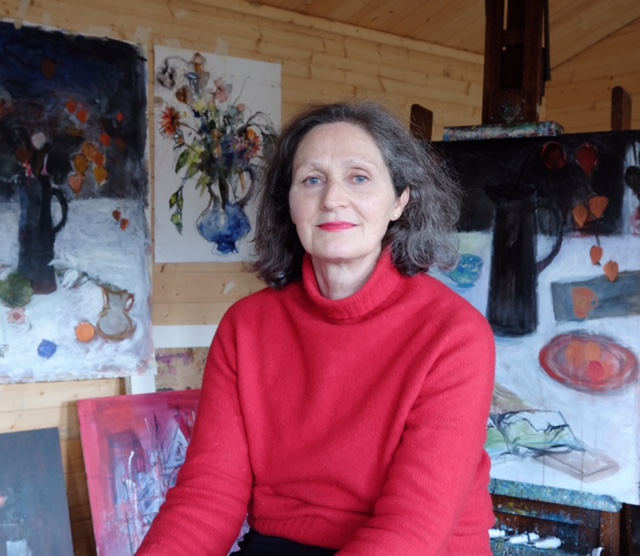Ann Oram Painter
Colour is a signature of your work. Discuss this using several of your paintings.
Colour and its use is a very Scottish thing. I think we have a lot in common with the French Impressionists also. Much more so than with the English painters who are more subdued in their use of colour.
We have the Scottish Colourists as part of our history, and I think I am part of that tradition.
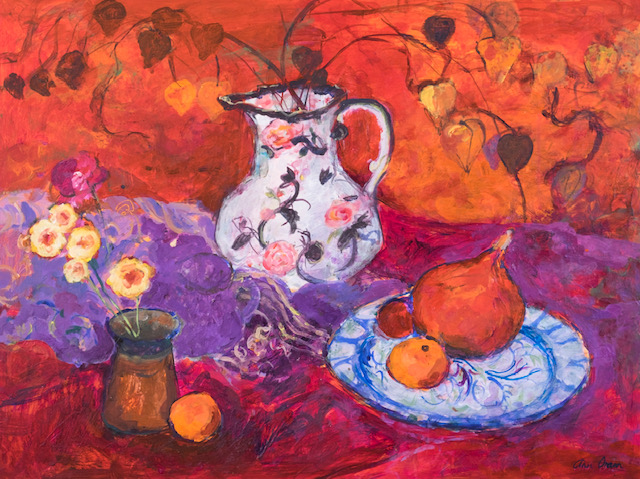
Red Still Life with Chinese Lanterns, Mixed media on Board, 41 x 41cms
For me, I couldn’t think of life without colour. It conveys so much in terms of mood and emotion. I also think it’s an antidote to the Scottish dreich climate!!
What led you to still life painting?
Still Life is a subject that was part of the curriculum at Edinburgh College of Art. All art schools taught it, as well as life painting, portraiture etc. I loved it and loved arranging the objects into attractive groups. I also like painting what I find to be beautiful.
Nowadays I start with a rough set up, and it changes over the painting period. Objects get painted out and replaced by something else!! It’s a moveable feast.
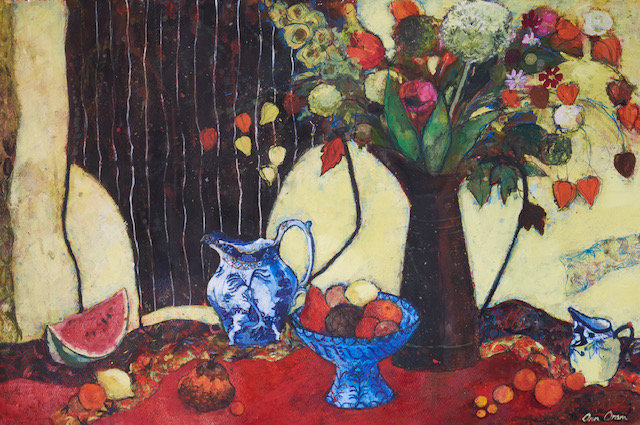
Autumn Fruit, Acrylic on watercolour paper, 67x101cms
Part of the fun is shopping for flowers and jugs and all the other bits and pieces. I’ve accrued quite a collection in my studio!
I was interested in Bonnard and Anne Redpath: both painters of still life, and in Bonnard’s case, he painted from memory and Anne Redpath kind of painted what was in her mind, rather than the set piece!! I’m with these guys as I love to go off piste with the group!!
Are there always flowers in your still life paintings?
There are always flowers in my still life. I don’t know why, but I think it’s to do with the pop of colour they give and also my love of everything floral!! I’m a bit of an addict.
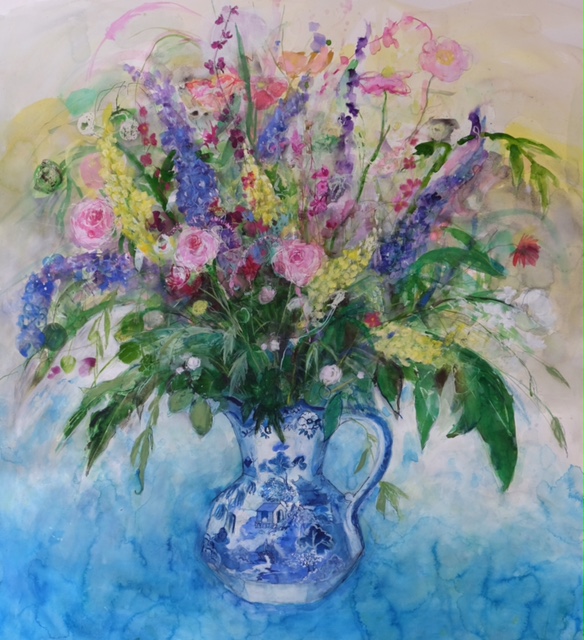
Flowers from an Edinburgh Garden, Watercolour and Gouache on Arches paper, 105x117cms
There are a couple of gardens I visit: One garden is at Wemyss Castle in Fife and the other one is where I buy my flowers at Millpond Flower Farm in the Borders. The sense of wellbeing I get from these environments is second to none.
You comment that, “Winter time and still life go together discuss.
This is a good time to paint still life as the weather is cold, and the studio is more inviting! I tend to work on single Flower pieces in the summer when the flowers are in season.
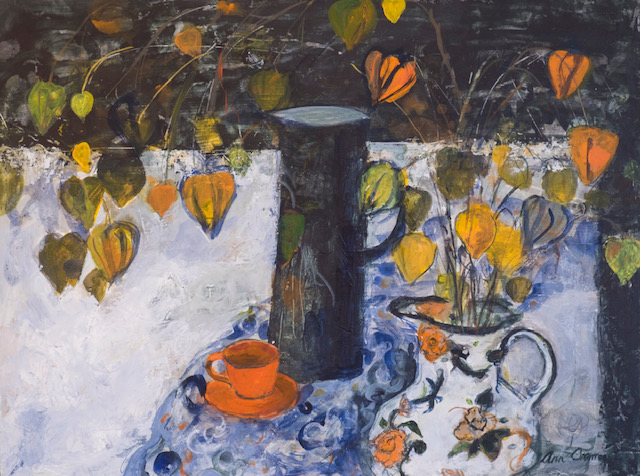
Two Jugs with Chinese Lanterns, Acrylic on gesso board, 51x61cms
You have many of your paintings made into prints.
I can make any painting into a giclee print. They are really for people wanting a nice image in their house without acquiring the original! Those prints are not signed, and I can print as many as I like. People often scroll through my Instagram account and request a print for instance!!
On the other hand, I have worked with professional printmakers through the years, and then it is a more serious business where the prints are editioned and signed. There might be 20-50 in the edition. With this method, the prints are screen prints.
I’d like to produce more prints, but I need to work with a professional. It’s a different approach to image making and I need that expertise. I have worked with a marvellous printmaker and artist called Gill Murray, and we are planning to work together again.
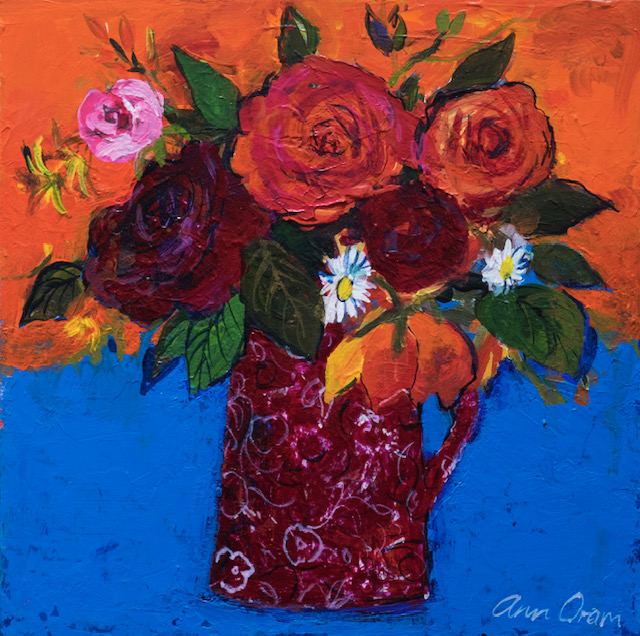
Wee Jug of Roses, Acrylic on gesso board, 30x30cms
Tell us about your Art School and how it has had to adapt to our new way of living in 2020?
I don’t teach every week. My painting schedule is too busy for that. What I tend to do is teach an intensive 2-3 days, where I work everyone quite hard!! Lots of exercises and techniques to free up the students’ work. We usually play all sorts of music and generally have a good time! I may do these courses about 8 times in the year.
With the pandemic, I have decided not to teach meantime, but hope to resume when things eventually settle down.
Your comment, “Ordinary landscape of Scotland” Is this what you see daily?
I like the landscapes that I see around me on a regular basis. It’s about what is accessible and what I love. I do make forays to the West coast of Scotland occasionally, but generally I like using what is local. I love our fields, and grasses. I don’t go for the dramatic glens particularly! I’ve included some landscape from Italy as well as Scotland in the photos I’ve sent.
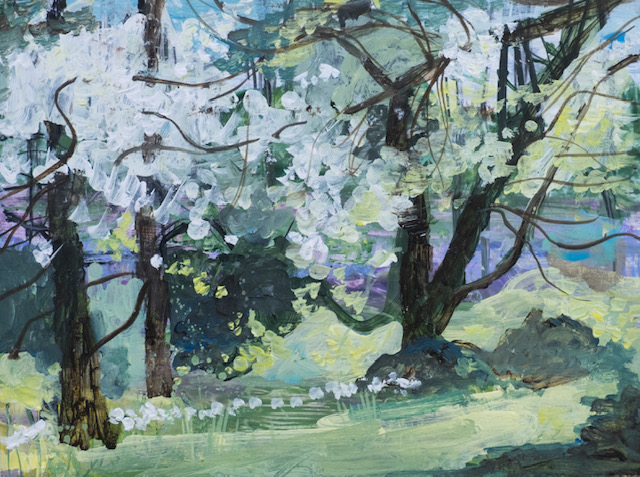
Trees at Paxton House, Acrylic on canvas board, 20x 30cms
Discuss your landscape art.
There’s really not much to say. If I’m out walking and see something that excites me, I will scribble down an image and usually record it on my iPhone. Familiarity is key; if I see something regularly it kind of fixes in my mind. I rarely paint on the spot but gather the images sometime later. This is where the creativity comes in and I muck around with wax candles, watercolour and gouache. Pen and ink too. The more finished paintings can go into acrylic paints, but I go between the two. Whatever I paint is not necessarily true to what I saw originally!!
I also introduce still life into the landscape or more truthfully into a garden scene. It’s an attempt at ‘feel good’ picnics in the garden! Bottle of wine, cheese, lovely plates and glasses!! Again, garden flowers will feature. Perhaps I am a creature of the good life!!
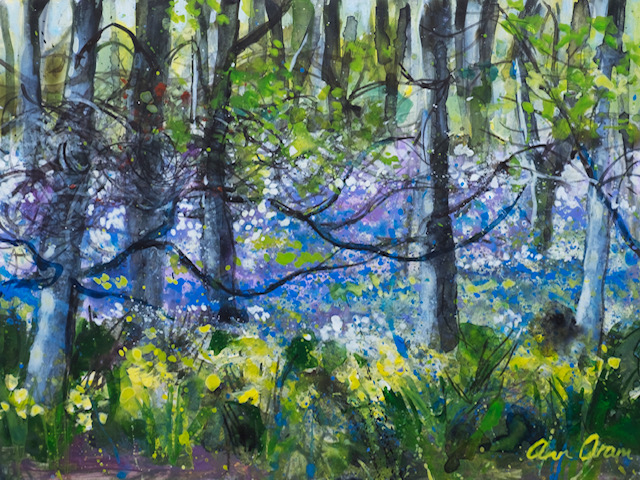
Bluebell Wood, Wemyss Castle, Acrylic on board, 20×30 cms
Discuss the differences that light plays out in your paintings both inside and outside.
Good light is important for still life. However, when you paint outside, good light is often the enemy. I think that early morning and light at the end of the day are hugely important. The skies are more interesting than when you get bright blue skies and full sunshine. I like the winter landscape especially, where the trees are bare, and the shadows are long. Snow and icy conditions are also exciting visually.
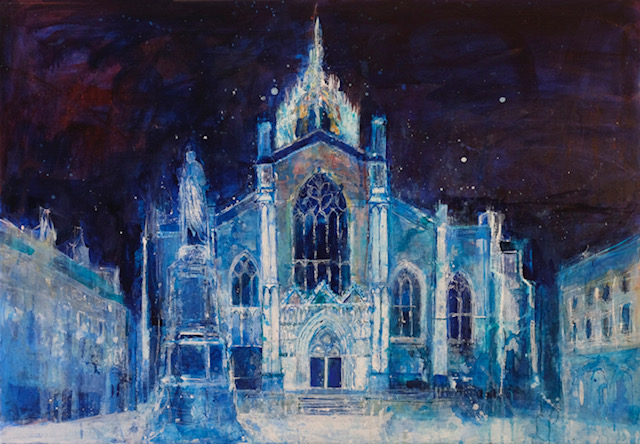
St Giles, Edinburgh at Night, Watercolour, ink, oil pastel on watercolour paper, 56x76cms
Compare you acrylic and watercolour, discuss how, where, and why you use both mediums.
This is an interesting question. I think I was always drawn to a water based medium. I found that when I bought my first acrylics, I instinctively felt I knew how to use them. The various mediums that can give you texture, and line (string gel) are exciting. I can glaze and use the Golden Liquid paints just like watercolour. It’s so exciting and creative.
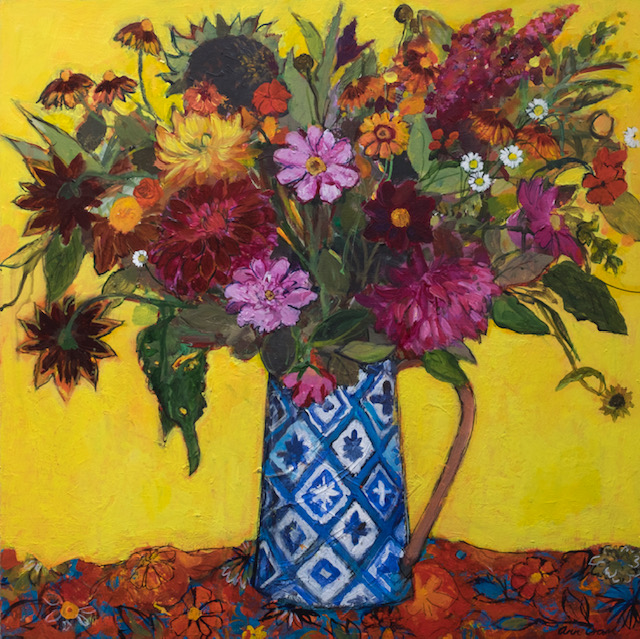
Late Summer Flowers on a Yellow Ground, Acrylic on gesso board, 68x68cms
My first love was watercolour, and sadly I am using it a bit less now. However, it’s good to look back and realise that the watercolour/gouache and inks are actually very exciting and freeing. I am about to start using the mixed media this winter, starting next week. The major difference for me is that the acrylic can give me more intense colour over bigger pieces. However acrylic inks fill that gap. I love using wax relief, or oil pastel with watercolour as it gives the most exciting texture. The gouache can give me wonderful opaque colour. My very big flower pieces are achieved on this way. Another point is that you can work very quickly with this technique. The mark making is fast and exciting and you must react quickly to the image appearing in front of you. I like to challenge myself and try to do paintings very quickly, or in one day!! It can be scary in a way that the build-up of acrylic paint is more considered. I can hardly wait to start!!
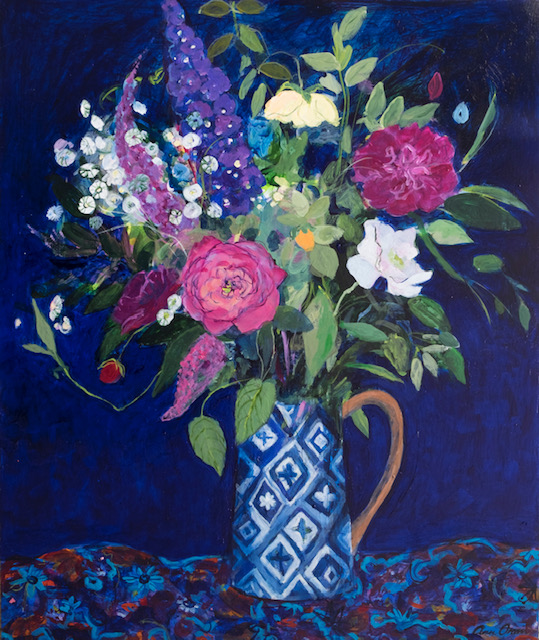
Midsummer Flowers on a Blue Ground, Acrylic on gesso board, 60x60cms
You exhibit in many galleries, what are two criteria you want and why.
This has changed a lot. The market is burgeoning with artists. New and old. Lots of people are changing career and becoming artists overnight. Many new galleries have sprung up, and of course there is more wealth around than there was 40 years ago. A lot of galleries really serve the interior design market.
I used to have one London and one Edinburgh gallery, a couple of provincial galleries and my teaching. Now, that picture has changed and I now work with many more galleries, throughout the country.
My main criteria is that I like the gallery and its director, and the space.
The second criteria is that you like the artists (or some of them) that they show. Being able to talk to your gallery is important.
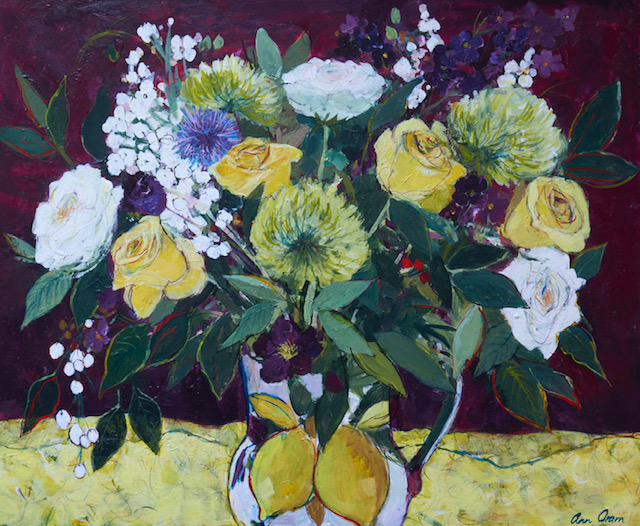
Roses and other Flowers, Acrylic on gesso board, 50x60cms
Tell us about your studio space.
Studio space is important. I’ve usually worked in a room in my house, and I have never shared a space. I don’t share!!
When we moved to the Borders, we bought an old Bakehouse in our village. It came with a piece of ground where the stables had once been. When we acquired it, the land was used for fly tipping and was full of weeds!! This has been cleared and we built a posh garden shed called ‘The Shedio’!! It is a lovely wooden structure which is warm and full of light. It has such a nice feeling, that we sometimes sit there as a family and share a glass of wine and cake!
As for lighting, we use battery power for the daylight tube. We hope to get electricity in next year.
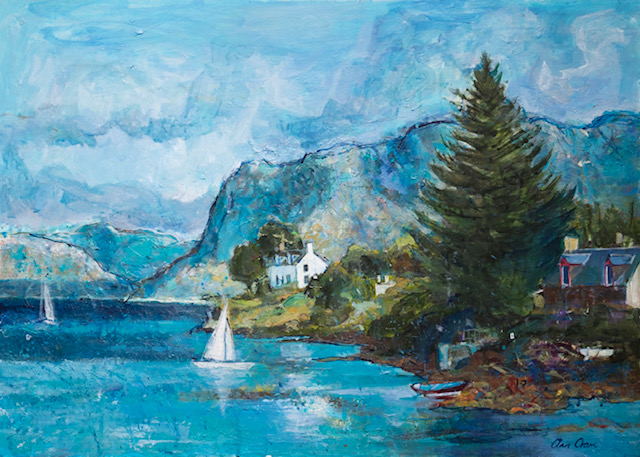
Plockton, Sailing Boats, Acrylic on gesso board, 50×70 cms
Do you keep a sketch book, and do you also use photography as a base for you work?
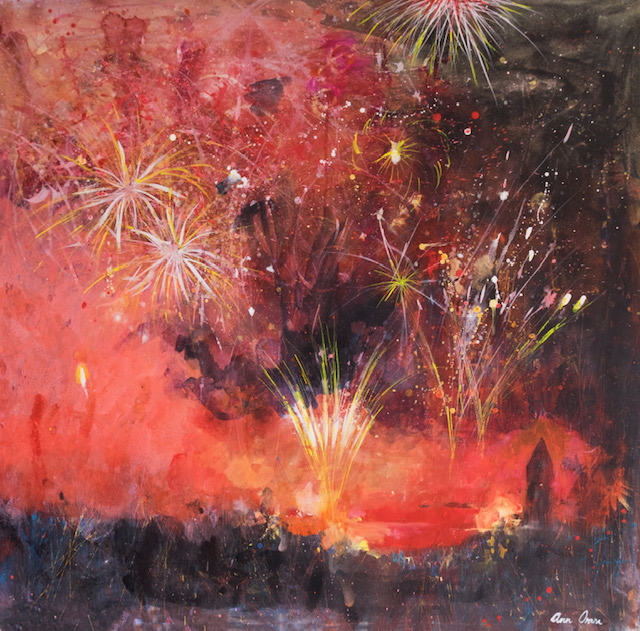
Edinburgh Festival Fireworks, Acrylic on Arches watercolour paper, 114x115cms
I do keep sketchbooks for set projects like foreign travel and for a project about my local landscape which was started earlier this year. They are full of scribbles and splashes of colour. I rely on my iPhone and camera to capture moments and weather. In fact, I recorded the icy shrubs and grasses on the road outside our village on my phone. You simply cannot sit out there and paint them in that situation. The best sketchbooks are in your head. It’s the familiarity of your surroundings that are important.
Contact:
Ann Oram RSW
Deborah Blakeley, Melbourne, Australia
Interview by Deborah Blakeley, November 2020
Think a colleague or friend could benefit from this interview?
Knowledge is one of the biggest assets in any business. So why not forward this on to your friends and colleagues so they too can start taking advantage of the insightful information the artist has given?
Other artists you may be interested in:


